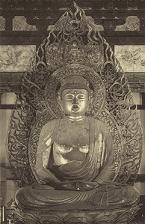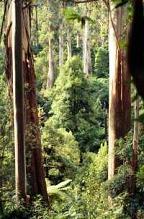MURYOKO

'Infinite Light'
Journal of Shin Buddhism
GREGG HEATHCOTE
Dreamings of Shinran, old and anew
(Dharma talk by Rev. Jo'on Gregg Heathcote for Gotan-e at the Hongwanji Buddhist Mission of Australia Headquarters on Sunday 21st May, 2006.)
Shinran Shonin was born in the village of Hino, situated on the south-eastern outskirts of Kyoto, on the 21st day of the fifth month in the year 1173. Our Gotan-e service today celebrates this watershed event, by extension celebrating all the blessings flowing from the Master's birth down the centuries to people everywhere.
Yet it is notable that, as with the founders of other Buddhist denominations in Japan, formal commemoration of Shinran's birthday was only instituted during the Meiji period. This was of course a time of rapid change and innovation, the period during which the modern Japanese nation was born. It seems appropriate then that these new Gotan-e services became associated with Hatsu-mairi, the formal presentation of infants to the Buddha and Sangha for the first time. With Australian Jodo Shinshu itself in its infancy, Gotan-e here and now seems equally appropriate.
But the burning question remains who or what in the first instance was this child, born so long ago and so far away, destined to ultimately become known to us as Shinran. What does this distant birth continue to mean? In the early days of Jodo Shinshu the prevalent view was of Ogen Shinran - ie 'Shinran, the Miraculous Appearance', Shinran born as the human incarnation of a sacred providence much more than human. Hence we have recounted in her letters Eshinni's revelational dream of the bodhisattva Kannon being manifest in the greatly revered person of her own husband. The Godensho furthermore records and lends credence to the dreams of other contemporary followers of Shinran intimating the Shonin's innermost identity as an emanation of the Amida Buddha himself.
However, such olden dreams and traditional perspectives seeing in Shinran a magnified embodiment of enlightened mind have tended to be impatiently down-played in modern times. The modern view has by contrast favoured shedding light upon Ningen Shinran - ie 'Shinran, the Human' honoured in all humility as an authentic, if flawed, seeker-after-truth to whose exemplary personal story every human being can deeply relate. Thus the modern celebration of Shinran's humanity has coincided with the initiation of celebrations of his nativity, perhaps making the Gotan-e service a modest sign of the times for the Shonin's followers today.

Certainly, a visit to Hino nowadays can still readily summon the spirit of the Shonin as a very human little child. It remains a quiet area on Kyoto's margins. The small Hino Tanjo-in temple there purportedly marks Shinran's exact birthplace. The Hongwanji kindergarten playground beside it is doubtless a space in which the young Shinran would likewise have played with neighbourhood friends. However the ancient, ancestral temple of Hokai-ji on the playground's other side calls to mind the precious child's more anguished moments. We are told Shinran suffered the early loss of both parents, and we know his family lived beset by dangers acutely attending their perilous times. It was not for nothing then that by the time of his ordination at age nine Shinran had developed an intense sense of vulnerability before the world's painful transience. Within Hokai-ji there is a magnificent sculpted image of the Buddha Amida at the foot of which young Shinran himself may have sat. There it is poignant still, feeling for that distressed child centuries ago looking up to the Buddha for reassurance.
Perhaps some may feel furthermore that this real, raw humanity of the youngster belies and dims those olden dreamings of Shinran as tariki incarnate, as a miraculous personification of Compassion's working wonders. Those seeking the clear incandescence of divine power tend to be blinded by it. Consequently I would like to offer a recent dreaming of my own. It comprises a suitably Australian illustration of the oneness with which we should rightly see this naturalness of the child-Shonin's callow humanity; the material naturalness of the wood from which the Heian-period Hokai-ji Buddha image was so beautifully called into being; and the naturalness of Amida's infinitely wholesome life flowering through it all.

Aboriginal peoples of Australia refer to the reality of spiritual vision as their 'dreaming', binding them intimately with the land and with the kinship of everything living upon it. Very gladly then do I tell of my own recent dreaming of the giant Mountain Ash forests of Australia's south-eastern high country. Mountain Ash (ie Eucalyptus regnans) is the tallest flowering plant on Earth, and before the arrival of timber-felling European settlers in their ancient Australian home ranges these were reportedly the tallest of all the world's trees, exceeding 129 metres (420 feet) in height. So incredibly immense were the largest of the Mountain Ash that once felled the remaining stumps were sometimes hollowed-out by settlers for use as huts, small churches or stables.
As with the towering human life of Shinran Shonin it is easy to be awed by these lords of the forest in their sublime maturity, dwelling upon the way benign giants shelter other living things in the vital watershed ecologies they structure. But such great lives do not fall to Earth complete from the sky, or from a distant Pure Land of Compassion for that matter. In truth Compassion's power can be characterised as the express togetherness of all that is, its larger life indwelling and working through life not in a supernatural, but in a superbly natural way. Whether with a newborn Japanese saint or a tiny Australian Mountain Ash seedling, tariki as tireless naturalness grows lives from the ground up, bringing soiled seeds germinating in dirt and darkness into the sustaining light.
Moreover, if Compassion is indeed a wondrous working-togetherness, it is not with outstanding, stand-alone lives that the natural wholeness and power of tariki brilliantly comes through. No, it is within the symbiotic strength of Shinran-Kannon, as experienced in Eshinni's dreaming, and within the comparable symbiotic strength of the Mountain Ash forests experienced in the Australian Shinshu dreaming of my own, that life's true leading edge is to be found.
'Symbiosis' refers to the cooperative and interdependent relationships between living beings, enhancing communal fitness for life and bringing lifeforms together in creative processes of organic co-evolution termed 'symbiogenesis'. Symbiosis and symbiogenesis are everywhere. Complex lifeforms such as ourselves would never have evolved without them, every countless cell of every sentient creature on this planet born and born again of life's remarkable natural history of symbiotic alliances and mergers, literally building our bodies out of their burgeoning relationships.
The same natural history equally applies to the evolution of plants, including the giant Mountain Ash. But with the Mountain Ash there is an additional twist, for the Ash like all eucalypts must contend in Australia with some of the oldest and most depleted soils in the world. In consequence eucalypt trees have only evolved, and continue to successfully grow today, in close symbiotic association with fungi in their root systems, assisting them to secure the nutrients they need. So it is with the Mountain Ash, the tallest of flowering plants - its clouds of white blossom on high wholly grounded in such humble relationship. For this reason perhaps Australian Buddha images of the future may not sit or stand on lotus thrones, but on blooming branches of Mountain Ash.
In the lofty realm of modern Buddhist thought the equivalent Japanese term for 'symbiosis' is 'kyosei', literally translating as 'co-living'. The fundamental significance of kyosei is particularly apparent in the work of the eminent Jodo Shu scholar Professor Benkyo Shiio, who brings a freshness to the age-old Buddhist teachings of tariki working through a world of interdependence. In the evocative words of Ryojun Sato of Taisho University, kyosei denotes 'networks of other powers', a whole symbiotic ecology of Compassion working across time and space to bring beings to birth together in the Amida Buddha's Pure Land.
And in this 'whole symbiotic ecology of Compassion' the birth of Shinran Shonin is most definitely a watershed event. Master Shinran has in faith been the spiritual forefather of countless persons of shinjin. Was his advent not then symbiogenesis, the arising in shinjin of an especially strong symbiosis of Buddha and bombu opening wide the co-evolutionary pathway of the Pure Land through and through which all our humanly indebted lives have been immeasurably blessed. In this respect is Shinran's birthday evermore a day of birth for us all, and a happy birthday indeed.
Thanks to the Shonin.
Namo Amida Butsu